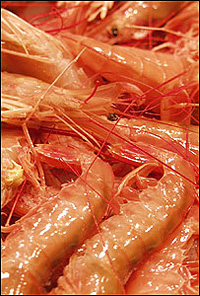 |
 |
 |
 Editorials | Environmental | November 2006 Editorials | Environmental | November 2006  
Shrimp Trawlers Look to Cut Waste
 BBC News BBC News


| | Shrimp trawling is described as the most wasteful form of fishing. |
For every kilogramme of shrimp caught, up to 20kg of other fish are unintentionally killed, says the UN Food and Agriculture Organization (FAO).

This amount of "bycatch" is a cause for concern for marine scientists. The FAO estimates that three quarters of the world's fisheries are either fully exploited or over-fished.

In countries such as the Philippines, people rely on fish for more than half of their protein intake.

"We prefer to have fish as our source of protein instead of meat because fish is good for our health and will not cause hypertension," nutritionist Aldela Ocenar tells TVE's Earth Report programme.

Yet the nation's population growth is so high that it is forecast to double within 30 years. Already the demand for fish exceeds what the surrounding seas can supply sustainably.

This has prompted the nation's Bureau of Fisheries and Aquatic Resources to experiment with Bycatch Reduction Devices (BRDs), which allow juvenile and smaller adult fish to pass through the trawl nets.

The bureau hopes this will reduce the amount of fish with little commercial value, known as "trash fish", being caught in trawls for shrimps.

"Bycatch Reduction Devices, effectively, are any modification to a fishing gear to reduce the amount of bycatch," says Jeremy Turner, from the FAO's fisheries department.

"There are two different types. One works [by] sorting the catch in terms of size; it will exclude either the larger species or the smaller ones."

"The other type of BRD is based on the behaviour of the fish," he added.

"Some of the fish have the intelligence or can respond to the visual stimuli of being able to see that there is a window of escape in the net."

However, the mayor of the coastal Calbayog City, Mel Senen Sarmiento, is unsure that BRDs will be enough.

"People have experimented reaching the Moon, but we do not invest much in our marine resources, which is there and we use it every day," he says.

"If people were able to spend so much money trying to reach the Moon, why not also spend money experimenting to ensure sustainability of our food supply in the years to come."

Turtle solutions

Guaymas is one of the major shrimp producing cities of northern Mexico. The shellfish is the nation's most important marine stock in terms of both foreign trade and employment.

According to government figures, Mexico produces more than 120,000 tonnes of shrimp each year, with a quarter being exported to the US.

Mexican fishermen also catch sizeable amounts of bycatch, which is thrown dead over the side of the boat because there is no demand for it.

"They have no interest in retaining bycatch, so they have every incentive to use a BRD, because it means less work for them," says Jeremy Turner.

Raul Molina, director of the National Institute of Fisheries, said one of the institute's most successful projects had been the introduction of BRDs.

"We have found that it is possible to reduce the impact of bycatch on various sorts of fish by using different technologies," he says.

One piece of equipment that is compulsory for fishing fleets is a Turtle Excluder Device (TED).

A TED is a grid that is placed inside a net. Shrimps and small fish can get through it but turtles cannot; they escape through a hole next to the grid.

Several species of turtle found in the waters around Mexico are endangered, and the creatures can damage nets and the shrimp catch. Also, shrimps can only be legally exported to the lucrative US market if they were caught in nets fitted with TEDs.

Andres Grajeda, president of Mexico's Small Fishermen's Guild, says small-scale operations benefit the most from BRDs being fitted on trawl nets.

"A trawler will catch 50-100kg of shrimp but may also catch 100-300kg of red snapper with an average weight of 150g, which is not commercial."

Mr Grajeda says the fish are killed and thrown back in to the sea, but adds that if they were allowed to mature then there would be a market for them.

He adds that fishermen need species such as red snapper because shrimp catches are falling, and so too are incomes.

To meet the booming demand for the shellfish, an increasing number of shrimp farms are being established.

"Fish farms are not here to compete with the sea but to help to avoid marine species in the wild, such as shrimp, being reduced too much," says Ricardo Loreto Lopez, a technical director for a shrimp farm company.

However, Jeremy Turner says that technology and science can only go so far in offering solutions to the pressures on the world's fish stocks.

"We are looking at a social problem and economic problem because the reason so much bycatch is being caught is to meet the needs of the poor people," he believes.

"So in that case, we come back to some of the big issues like good governance, equity, social justice - but then we are getting beyond potted shrimps." | 
 | |
 |



